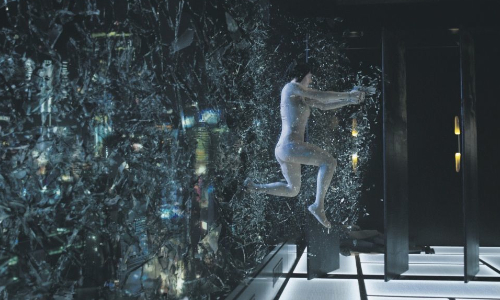Review: Ghost in the Shell

This remake of the seminal 1995 anime – itself based on an earlier manga series – has been a source of major anxiety for fans. Much of the controversy has centred on the casting of a white actor in the lead role – something the film actually handles relatively delicately – but also this is Ghost in the Shell, dammit, please don’t ruin this.
Rupert Sanders (Snow White and the Huntsman; Having An Affair With Kristen Stewart) treads lightly. He’s clearly a fan. Many scenes – all of the best scenes – are lifted directly from the anime: a frame-by-frame recreation of the famous fight on a flooded plaza, right down to the plane flying overhead; a face-off against a terrifying, futuristic tank; the main character crackling into invisibility as she drops in slow motion from a rooftop.
Ghost in the Shell follows The Major, a human brain in a synthetic body, plagued by “glitches” that may be fragments of a past life. She works for a shadowy government agency called Section 9, tasked with bringing down terrorists who have been “hacked” by a nefarious force.
The script, perhaps inevitably, focuses almost exclusively on Johansson’s character. In the source material, The Major’s significance to the over-arching plot was drip-fed, unfurling like a cybernetic rose. Here, she is the film’s everything, its heart and soul, its ghost and its shell. This is her back story, her revenge story and her coming-of-age story.
It’s a heavy weight to put on Johansson’s nude-bodysuited shoulders. But – whisper it – she’s excellent. Her blank stare says a thousand words. There is depth and sadness and wonder in those artificial eyes. She’s both sexy and sexless.
But the wider the story is undeniably weaker and less enigmatic for these narrative shackles, which stifle its ability to comment more broadly on the human condition. There’s an instinct to over-explain – this is how Batou got those eyes – and a misguided filling in of the blanks that at times veers dangerously close to a super-hero origin story. At best, it suffices. But when the film is this stylish, that’s probably enough.
The world borrows heavily from the tech-noir of Blade Runner – the scenes of the endless, blinking cityscape (filmed in Hong Kong) would be utterly mind-blowing if it weren’t for… well, Blade Runner. There’s also a heavy dose of the queasy neon used to such great effect in The Neon Demon and John Wick.
And while there’s no shortage of CGI – often in the form of sky-scraper-sized advertising holograms – there’s still a commendable amount of real stuff, giving Sanders’ film the air of the great sci-fi follies of yesteryear: Dune and Brazil and Total Recall. Adding to this sensation is Michael Pitt’s preposterous antagonist. He’s not an actor you hire for his deep reservoirs of subtlety, but his overwrought performance is distractingly daft.
But Ghost in the Shell is a qualified success. It’s a slick action film with short bursts of beautifully choreographed violence, set against a wonderfully gaudy, intricately textured backdrop. The film repeats a mantra: “It’s not our memories that define us, it’s what we do that defines us”. This Ghost in the Shell does just about enough to overcome our memories of its past lives.
First published in City A.M.

